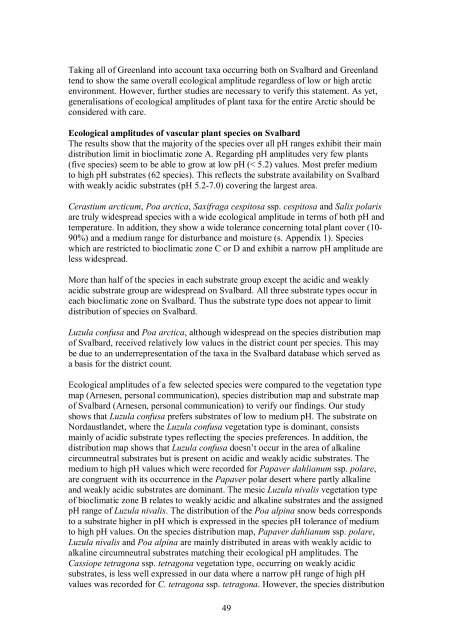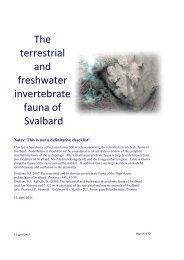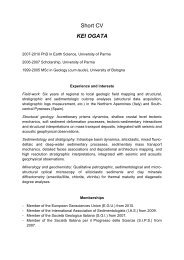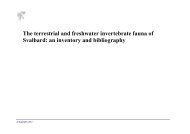Arctic plant ecology: From tundra to polar desert in Svalbard - Unis
Arctic plant ecology: From tundra to polar desert in Svalbard - Unis
Arctic plant ecology: From tundra to polar desert in Svalbard - Unis
You also want an ePaper? Increase the reach of your titles
YUMPU automatically turns print PDFs into web optimized ePapers that Google loves.
Tak<strong>in</strong>g all of Greenland <strong>in</strong><strong>to</strong> account taxa occurr<strong>in</strong>g both on <strong>Svalbard</strong> and Greenland<br />
tend <strong>to</strong> show the same overall ecological amplitude regardless of low or high arctic<br />
environment. However, further studies are necessary <strong>to</strong> verify this statement. As yet,<br />
generalisations of ecological amplitudes of <strong>plant</strong> taxa for the entire <strong>Arctic</strong> should be<br />
considered with care.<br />
Ecological amplitudes of vascular <strong>plant</strong> species on <strong>Svalbard</strong><br />
The results show that the majority of the species over all pH ranges exhibit their ma<strong>in</strong><br />
distribution limit <strong>in</strong> bioclimatic zone A. Regard<strong>in</strong>g pH amplitudes very few <strong>plant</strong>s<br />
(five species) seem <strong>to</strong> be able <strong>to</strong> grow at low pH (< 5.2) values. Most prefer medium<br />
<strong>to</strong> high pH substrates (62 species). This reflects the substrate availability on <strong>Svalbard</strong><br />
with weakly acidic substrates (pH 5.27.0) cover<strong>in</strong>g the largest area.<br />
Cerastium arcticum, Poa arctica, Saxifraga cespi<strong>to</strong>sa ssp. cespi<strong>to</strong>sa and Salix <strong>polar</strong>is<br />
are truly widespread species with a wide ecological amplitude <strong>in</strong> terms of both pH and<br />
temperature. In addition, they show a wide <strong>to</strong>lerance concern<strong>in</strong>g <strong>to</strong>tal <strong>plant</strong> cover (10<br />
90%) and a medium range for disturbance and moisture (s. Appendix 1). Species<br />
which are restricted <strong>to</strong> bioclimatic zone C or D and exhibit a narrow pH amplitude are<br />
less widespread.<br />
More than half of the species <strong>in</strong> each substrate group except the acidic and weakly<br />
acidic substrate group are widespread on <strong>Svalbard</strong>. All three substrate types occur <strong>in</strong><br />
each bioclimatic zone on <strong>Svalbard</strong>. Thus the substrate type does not appear <strong>to</strong> limit<br />
distribution of species on <strong>Svalbard</strong>.<br />
Luzula confusa and Poa arctica, although widespread on the species distribution map<br />
of <strong>Svalbard</strong>, received relatively low values <strong>in</strong> the district count per species. This may<br />
be due <strong>to</strong> an underrepresentation of the taxa <strong>in</strong> the <strong>Svalbard</strong> database which served as<br />
a basis for the district count.<br />
Ecological amplitudes of a few selected species were compared <strong>to</strong> the vegetation type<br />
map (Arnesen, personal communication), species distribution map and substrate map<br />
of <strong>Svalbard</strong> (Arnesen, personal communication) <strong>to</strong> verify our f<strong>in</strong>d<strong>in</strong>gs. Our study<br />
shows that Luzula confusa prefers substrates of low <strong>to</strong> medium pH. The substrate on<br />
Nordaustlandet, where the Luzula confusa vegetation type is dom<strong>in</strong>ant, consists<br />
ma<strong>in</strong>ly of acidic substrate types reflect<strong>in</strong>g the species preferences. In addition, the<br />
distribution map shows that Luzula confusa doesn’t occur <strong>in</strong> the area of alkal<strong>in</strong>e<br />
circumneutral substrates but is present on acidic and weakly acidic substrates. The<br />
medium <strong>to</strong> high pH values which were recorded for Papaver dahlianum ssp. <strong>polar</strong>e,<br />
are congruent with its occurrence <strong>in</strong> the Papaver <strong>polar</strong> <strong>desert</strong> where partly alkal<strong>in</strong>e<br />
and weakly acidic substrates are dom<strong>in</strong>ant. The mesic Luzula nivalis vegetation type<br />
of bioclimatic zone B relates <strong>to</strong> weakly acidic and alkal<strong>in</strong>e substrates and the assigned<br />
pH range of Luzula nivalis. The distribution of the Poa alp<strong>in</strong>a snow beds corresponds<br />
<strong>to</strong> a substrate higher <strong>in</strong> pH which is expressed <strong>in</strong> the species pH <strong>to</strong>lerance of medium<br />
<strong>to</strong> high pH values. On the species distribution map, Papaver dahlianum ssp. <strong>polar</strong>e,<br />
Luzula nivalis and Poa alp<strong>in</strong>a are ma<strong>in</strong>ly distributed <strong>in</strong> areas with weakly acidic <strong>to</strong><br />
alkal<strong>in</strong>e circumneutral substrates match<strong>in</strong>g their ecological pH amplitudes. The<br />
Cassiope tetragona ssp. tetragona vegetation type, occurr<strong>in</strong>g on weakly acidic<br />
substrates, is less well expressed <strong>in</strong> our data where a narrow pH range of high pH<br />
values was recorded for C. tetragona ssp. tetragona. However, the species distribution<br />
49








